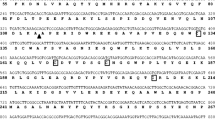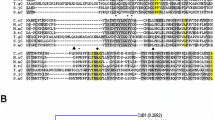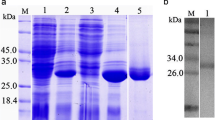Abstract
We have cloned, sequenced and expressed a gene of Haemonchus contortus that encodes a protein (termed HcCYP) consisting of a cyclophilin domain and an RNA recognition motif (RRM). An antiserum raised against the recombinant protein showed that HcCYP was present in the insoluble fraction (mostly nuclear) of the parasite homogenate. The recombinant protein possessed the typical cis-trans peptidyl-prolyl isomerase activity of cyclophilins and this activity was inhibited by the immunosuppressant cyclosporin A. The N-terminal portion of the molecule, carrying the RRM, was able to bind to nucleic acids, whereas the C-terminal portion did not have any binding activity. The possible function of HcCYP in the parasite is discussed on the basis of information available on similar proteins in other organisms.





Similar content being viewed by others
References
Galat A (2003) Peptidylprolyl cis/trans isomerases (immunophilins): Biological diversity – targets – functions. Curr Top Med Chem 3:1315–1347
Handschumacher RE, Harding MW, Rice J, Drugge RJ (1984) Cyclophilin: a specific cytosolic binding protein for Cyclosporin A. Science 226:544–547
Takahashi N, Hayano T, Suzuki M (1989) Peptidyl-prolyl cis-trans isomerase is the cyclosporin A-binding protein cyclophilin. Nature 337:473–475
Freskgard PO, Bergenhem N, Jonsson BH, Svensson M, Carlsson U (1992) Isomerase and chaperone activity of prolyl isomerase in the folding of carbonic anhydrase. Science 258(5081):466–468
Baker EK, Colley NJ, Zuker CS (1994) The cyclophilin homolog NinaA functions as a chaperone, forming a stable complex in vivo with its protein target rhodopsin. EMBO J 13:4886–4895
Harding MW, Galat A, Uehling DE, Schreiber SL (1989) A receptor for the immunosuppressant FK506 is a cis-trans peptidyl-prolyl isomerase. Nature 341:758–760
Klinkert MQ, Bugli F, Engels B, Carrasquillo E, Valle C, Cioli D (1995) Characterization of a Schistosoma mansoni cDNA encoding a B-like cyclophilin and its expression in Escherichia coli. Mol Biochem Parasitol 75:99–111
Vaitukaitis J, Robbins JB, Nieschlag E, Ross GT (1971) A method for producing specific antisera with small doses of immunogen. J Clin Endocr 33:983–991
Sugita M, Sugiura M (1994) The existence of eukaryotic ribonucleoprotein consensus sequence-type RNA-binding proteins in a prokaryote, Synechococcus 6301. Nucleic Acids Res 22:25–31
Khattab A, Pica-Mattoccia L, Klinkert MQ, Wenger R, Cioli D (1998) Cyclosporins: lack of correlation between antischistosomal properties and inhibition of cyclophilin isomerase activity. Exp Parasitol 90:103–109
Anderson M, Fair K, Amero S, Nelson S, Harte PJ, Diaz MO (2002) A new family of cyclophilins with an RNA recognition motif that interact with members of the trx/MLL protein family in Drosophila and human cells. Dev Genes Evol 212:107–113
Shieh BH, Stamnes MA, Seavello S, Harris GL, Zuker CS (1989) The ninaA gene required for visual transduction in Drosophila encodes a homologue of cyclosporin A-binding protein. Nature 338:67–70
Schreiber SL, Crabtree GR (1992) The mechanism of action of cyclosporin A and FK506. Immunol Today 13:136–142
Franke EK, Luban J (1995) Cyclophilin and gag in HIV-1 replication and pathogenesis. Adv Exp Med Biol 374:217–228
Montague JW, Hughes FM Jr, Cidlowski JA (1997) Native recombinant cyclophilins A, B, and C degrade DNA independently of peptidylprolyl cis-trans-isomerase activity. Potential roles of cyclophilins in apoptosis. J Biol Chem 272:6677–6684
Rycyzyn MA, Clevenger CV (2002) The intranuclear prolactin/cyclophilin B complex as a transcriptional inducer. Proc Natl Acad Sci U S A 99:6790–6795
Hoffmann K, Handschumacher RE (1995) Cyclophilin-40: evidence for a dimeric complex with hsp90. Biochem J 307:5–8
Crompton M, Ellinger H, Costi A (1988) Inhibition by cyclosporin A of a Ca2+-dependent pore in heart mitochondria activated by inorganic phosphate and oxidative stress. Biochem J 255:357–360
Kenan DJ, Query CC, Keene JD (1991) RNA recognition: towards identifying determinants of specificity. Trends Biochem Sci 16:214–220
Zeng L, Zhou Z, Xu J, Zhao W, Wang W, Huang Y, Cheng C, Xu M, Xie Y, Mao Y (2001) Molecular cloning, structure and expression of a novel nuclear RNA-binding cyclophilin-like gene (PPIL4) from human fetal brain. Cytogenet Cell Genet 95:43–47
Krzywicka A, Beisson J, Keller AM, Cohen J, Jerka-Dziadosz M, Klotz C (2001) KIN241: a gene involved in cell morphogenesis in Paramecium tetraurelia reveals a novel protein family of cyclophilin-RNA interacting proteins (CRIPs) conserved from fission yeast to man. Mol Microbiol 42:257–267
Zorio DA, Blumenthal T (1999) U2AF35 is encoded by an essential gene clustered in an operon with RRM/cyclophilin in Caenorhabditis elegans. RNA 5:487–494
Teigelkamp S, Achsel T, Mundt C, Gothel SF, Cronshagen U, Lane WS, Marahiel M, Luhrmann R (1998) The 20 kD protein of human [U4/U6.U5] tri-snRNPs is a novel cyclophilin that forms a complex with the U4/U6-specific 60 kD and 90 kD proteins. RNA 4:127–141
Author information
Authors and Affiliations
Corresponding author
Additional information
P Note: The nucleotide sequence reported in this paper is available in the GenBankTM database under the accession number: AY754868
Rights and permissions
About this article
Cite this article
Valle, C., Troiani, A.R., Lazzaretti, P. et al. Molecular and biochemical characterization of a protein cyclophilin from the nematode Haemonchus contortusP . Parasitol Res 96, 199–205 (2005). https://doi.org/10.1007/s00436-005-1329-3
Received:
Accepted:
Published:
Issue Date:
DOI: https://doi.org/10.1007/s00436-005-1329-3




